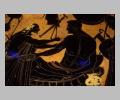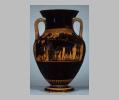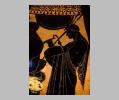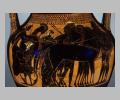| Collection: | Toledo Museum of Art |
| Summary: | Side A: the ransom of Hector. Side B: warriors departing. |
| Ware: | Attic Black Figure |
| Painter: | Attributed to the Rycroft Painter |
| Date: | ca. 520 BC - 510 BC |
| Dimensions: | H. 68.6 cm., D. of rim 34.0 cm., D. of body 45.0 cm., D. of foot 25.7 cm., W. of handles 7.0 cm. |
| Primary Citation: | |
| Shape: | Neck amphora |
| Period: | Archaic |
Condition:
Black glaze occasionally fired mottled-red.
Decoration Description:
Side A: The ransom of Hector. Achilles (second from the right), wreathed and beardless, reclines on his couch. His himation is draped loosely around his legs and waist, and he holds a phiale in his extended right hand. Priam, in the center of the scene, wears a chiton and himation and strides towards Achilles, his arms extended imploringly. Hektor's nude corpse lies on the ground in front of Achilles' couch and food-laden serving table. To the left of Priam is a youth who carries the ransom goods: a tripod and three stacked phialai. He wears a short chiton and grasps a leg of the tripod with each hand and carries it with the cauldron above his head. The phialai rest in the crook of his right arm. The upper two are incised with loops (as is Achilles'), the lowest one with simple curved strokes. Hermes, wearing a winged pilos, a chlamys and boots, stands at the far left, holding the kerykeion in his right hand. At the far right stands a serving girl wearing a chiton and himation and holding a hydria. She moves left towards the center, the hydria is another part of the ransom. Hektor's corpse lies on its back, the legs bent at the knees. His left hand is drawn as if it were a right hand (as is Achilles' left hand). His right arm is shown resting on his body and thigh. Priam's legs are drawn in front of Hektor's body, but his left hand is on the far side of Achilles' right shoulder. On the wall behind Achilles hangs a high-crested Corinthian helmet, a sword in its scabbard and a round shield. A pair of spears leans against the wall to the right of the shield. Achilles reclines on a thick mattress, with a pillow at his back. For the inscription in the field, cf. Added red: Hermes' fillet, forehead hair, beard, dots on his chlamys and short strokes along its lower border, and the flaps of his boots; the youth's forehead hair, belt and dots on his chiton; the upper and lower borders of Priam's himation and dots thereon; Achilles' wreath, the upper border of his himation and dots thereon; Hektor's fillet, beard and bloodstains on his chest; dotted borders of the serving maiden's hair ribbon, the borders of her himation and dots thereon; the attachments for the rings of the tripod, the eye of the helmet, strokes on the scabbard and stripes on the pillow. Added white: Priam's hair, eyebrows and beard; the serving maiden's flesh the border of the helmet, the decorations on the couch leg and a stroke (accidental?) above the food at the right of the table.
Side B: Warriors departing. A charioteer, on the far left, steps into a chariot. He holds the reins in both hands and in his left hand a goad as well. He wears a long robe and a nebris, and a Boeotian shield hangs at his back. A warrior, second from the left, stands on the far side of the chariot and faces the charioteer. He wears a low-crested Corinthian helmet and greaves, and carries a round shield (the device on which is a lion protome) and a spear. Next to the warrior is an old man who wears a chiton and himation. He looks anxiously towards another warrior who stands behind the horses and moves to the right, but looks back to the left at the old man. He wears a low-crested Corinthian helmet, a short chiton, greaves and carries a Boeotian shield and a pair of spears. At the far right stands a third warrior facing left. He, too, wears a low-crested Corinthian helmet, short chiton, greaves and carries a Boeotian shield. Behind this third warrior (and largely concealed by him) stands an archer. Parts of his cap, bow, quiver and trouser legs are visible. For the inscriptions in the field, cf. Added red: The flanges of the charioteer's Boeotian shield at the top and bottom; the border of the (second from the left) warrior's shield; dots on the old man's himation; the nose-guard and a band on the helmet of the (fourth from the left) warrior. The border of the shield of the warrior on the far right; parts of the chariot; the tail, mane and breastband of the near trace-horse; the breastband of the near pole-horse; the mane of the off pole-horse; the yokepad. Added white: The charioteer's baldric and patches on his nebris; the shield device and two rows of dots on the helmet-crest of the (second from the left) warrior; Priam's hair and beard; the helmet-crest of the (fourth from the left) warrior; the border of the helmet-crest of the warrior on the far right.
The panels are bordered above by a palmette-lotus chain and below by a simple groundline over a narrow reserved band. The sides of the handles are decorated with a double row of ivy leaves. A band of added red appears above the palmette-lotus border, two bands of added red below the panels, and another above the rays at the base. There is also added red over black glaze on the base fillet. The outside of the handle edges also have added red. The flat upper surface of the rim is reserved; the mouth is glazed to a depth of 4.6 cm, but the interior of the neck is reserved.
Attributed by Dietrich von Bothmer. For a calyx-krater by this painter, also in the Toledo collection and included in this exhibition, see
The Rycroft Painter, so-called after a type A amphora (like the Toledo amphora) once in the Rycroft collection, the Spencer-Churchill collection and now in the Ashmolean Museum,
The main panel (Side A) illustrates a well-known scene from Homer's Iliad (Archaische Schildbänder, Olympische Forschungen II (Berlin 1950) 145-148AntK 7 (1964) 82 ff.The Iliad in Early Greek Art (Copenhagen 1967) 127 ff. and 267-268
The Rycroft Painter's work has two distinguishing quirks which can be seen on the Toledo amphora: the rendering of left hands as right (supra, Side A, Achilles and Hektor's corpse; see also JHS 74 [1954] 229-230)
Shape Description:
Type A Neck amphora
Inscriptions:
Inscriptions in the fields of both sides A and B.
Essay:
Collection History:
Gift of Edward Drummond Libbey.
Sources Used:
Other Bibliography:
Toledo Museum News 19 (1976) 47





